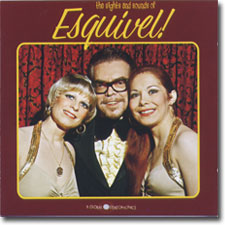Esquivel
- title
The Sights and Sounds of Esquivel!
- label
Bar None
- format
- CD
 Bienvenidos a la Margarita!
Bienvenidos a la Margarita!
In 1974 (the year is disputable from what my sources tell me), Juan Garcia Esquivel and six other musicians set out to create this live promotional recording as a source of material for showcasing the current Esquivel band—a much smaller ensemble than that heard on the wiz-bang productions he put out in the 1960’ s. The album was made to showcase the act he was putting on at a Mexican food joint in Chicago. However, upon first listening to this record, I actually thought of Las Vegas. Red vinyl booths, red glass corrugated candleholders, and powder-blue tuxedos all came to mind, in part thanks to the photography in the liner notes.
But, this isn’t a live lounge performance in Vegas nor does it come across like a rare find you just have to have. I’ve heard some live Esquivel in Vegas and this doesn’t compete. The music on this CD isn’t up to par with either those Vegas recordings, or the classic records from the 60s that I’ve come to love and which define Esquivel for me.
The music on this CD is primarily a collection of vocal-driven songs that too often lack the appropriate dosage of “Esquivel concentrate.” The organ is prominent, and adds a strong character to the record I was not used to on previous Esquivel records. I am guessing Esquivel chose to use organ in this small group due to the tessitura and density capabilities of the instrument. But, the organ as a pseudo horn section pales in comparison to Esquivel’s previous brass and woodwind sections.
 As with many Esquivel CDs, percussion plays a prominent role, especially the role of the bongocero (Jimmy Lara). And as any WAITIKI fan knows, we love the scraping “chi-yah chih-chih” of the guiro and there is plenty of that on this record! Track 4 is actually titled La Raspa which literally means “the scraper” and as such, features the guiro.
As with many Esquivel CDs, percussion plays a prominent role, especially the role of the bongocero (Jimmy Lara). And as any WAITIKI fan knows, we love the scraping “chi-yah chih-chih” of the guiro and there is plenty of that on this record! Track 4 is actually titled La Raspa which literally means “the scraper” and as such, features the guiro.
The closing track (Good Night) is the first instance I can recall where Esquivel uses the newer vibraslap instrument in place of a real quijada.  The quijada is the jawbone of a donkey that the player strikes, rattling the attached teeth to create a unique sound heard in many Esquivel arrangements on his other albums. LP Music, the most well known maker of today’s latin percussion instruments, created a more practical substitute for the quijada in the 1960 ’s (I think) called the vibraslap.
The quijada is the jawbone of a donkey that the player strikes, rattling the attached teeth to create a unique sound heard in many Esquivel arrangements on his other albums. LP Music, the most well known maker of today’s latin percussion instruments, created a more practical substitute for the quijada in the 1960 ’s (I think) called the vibraslap.
Instrumentation aside though, my love of Esquivel’s music really stems from what the man did as an instrumental arranger and “sound compiler” on albums like Infinity in Sound, Other Worlds, and Exploring New Sounds in Stereo.  The mastery of Esquivel to me lies in his orchestration talents—the musical way he adds subdued humor to the art and creates his own genre in the process. Sights and Sounds doesn’t always reinforce this image.
The mastery of Esquivel to me lies in his orchestration talents—the musical way he adds subdued humor to the art and creates his own genre in the process. Sights and Sounds doesn’t always reinforce this image.
I could probably play the bluesy Good Morning Heartache and ballad Estrellita for an Esquivel fanatic and they would have no way of knowing that they came from one of his recordings. Listening to his big-band version of La Mantilla next to the take on this CD made me almost depressed. It’s a reminder of the financial struggles realized by large big bands and how unfortunately, dinero can affect an artist’s individual sound.
Trimming the band down also has the effect reducing the “Esquivelness” too. Perhaps if I had doubled up on the Vodka & Frescas (Esquivel’s “new taste sensation”) I wouldn’t have noticed this as much. But, if you like Mexican canciones (Perfidia, Manicero), and can imagine Esquivel covering gospel and Gershwin with just seven pieces (Delta Dawn, Rhapsody in Blue), and you love Esquivel for his distinct personality, then the record is probably worth adding to your collection.
There is a nice surprise on the CD. While transcribing Esquivel tracks for the 21-piece WAITIKI “Orchestrotica,” I got to know Esquivel’s style as an arranger on an intimate level. However, I lacked anything but second-hand knowledge of the man as a person (mostly from colorful anecdotes told by “our” mutual friend, Brother Cleve). On Sights and Sounds, you get a chance to hear Esquivel speak to the “[f]au[x]dience” and perhaps get a glimpse of what the man was like in real life (keep in mind though he had his performer face on during the recording). I enjoyed these anecdotes, even if they are somewhat hokey (Delta Dawn). Perhaps it gives an insight into Esquivel’s true personality (La Mantilla)?
Sights and Sounds isn’t the best Esquivel release I have ever heard but depending on why you like Esquivel, it may be worth a trip over to bar-none.com for more info. Best of luck in 2006 to everyone else who, like me, is always on the lookout for Esquivel records in the used bins. I wonder if “space-age bachelor pad” will become an official Itunes genre in 2006?